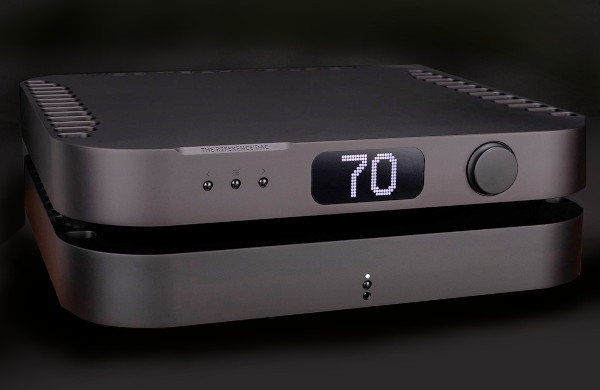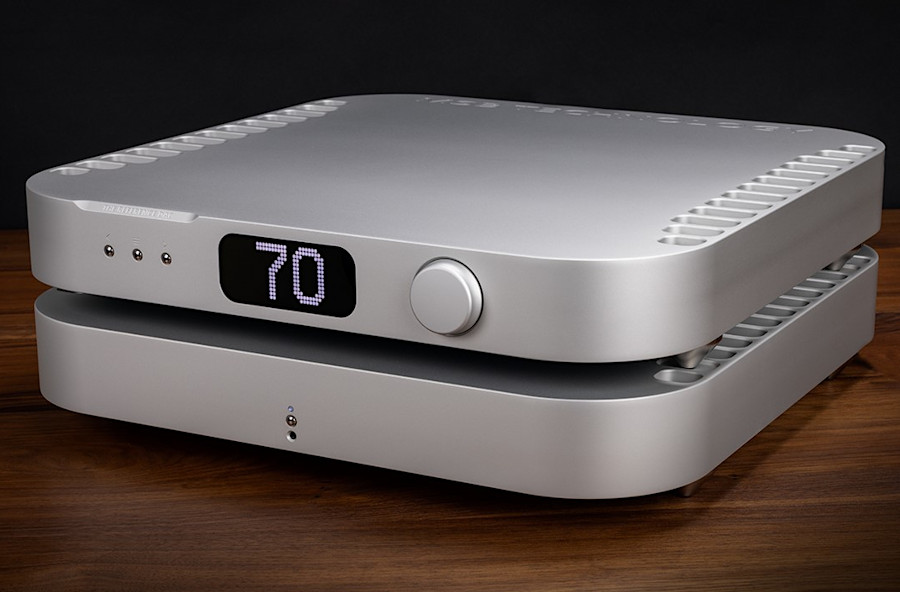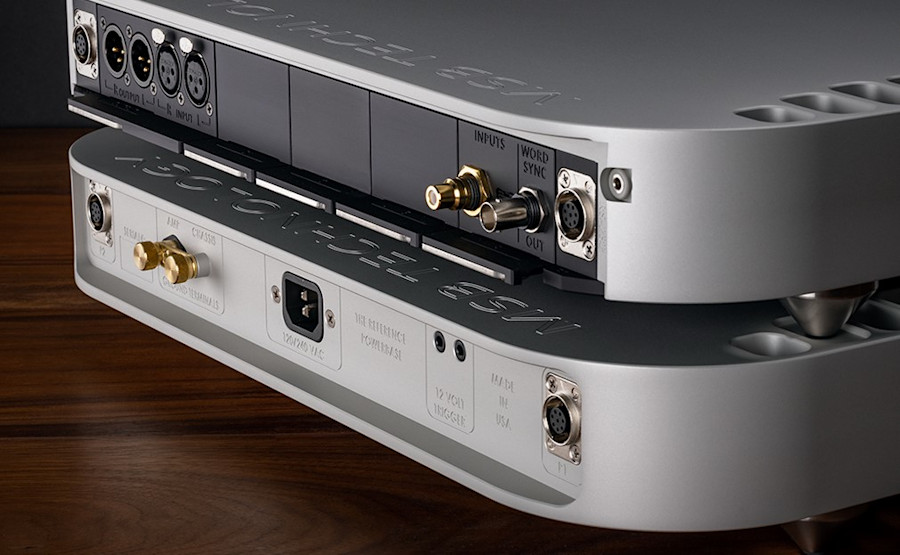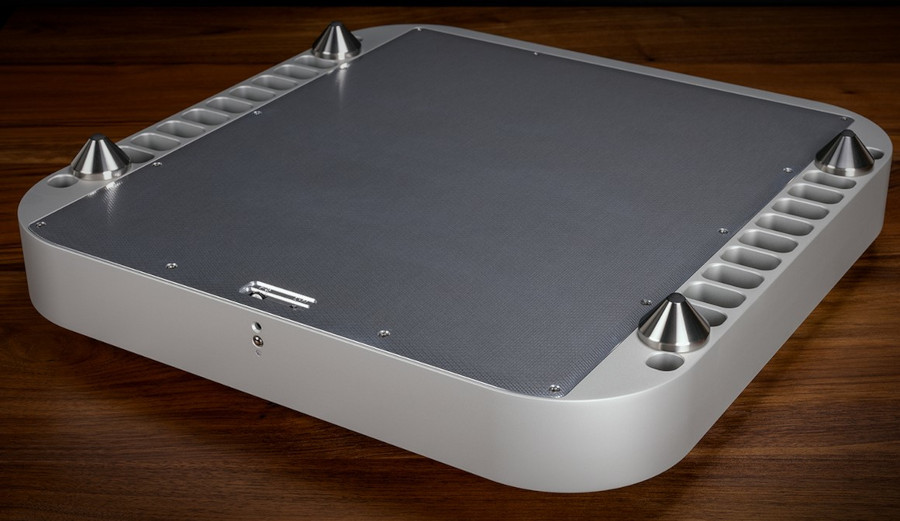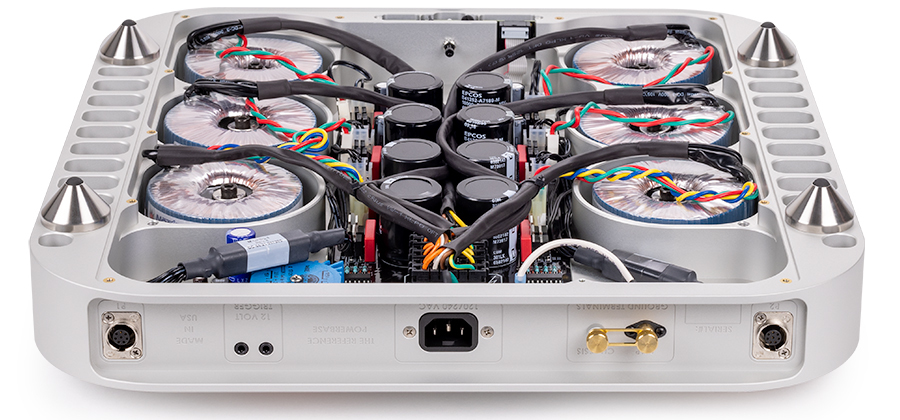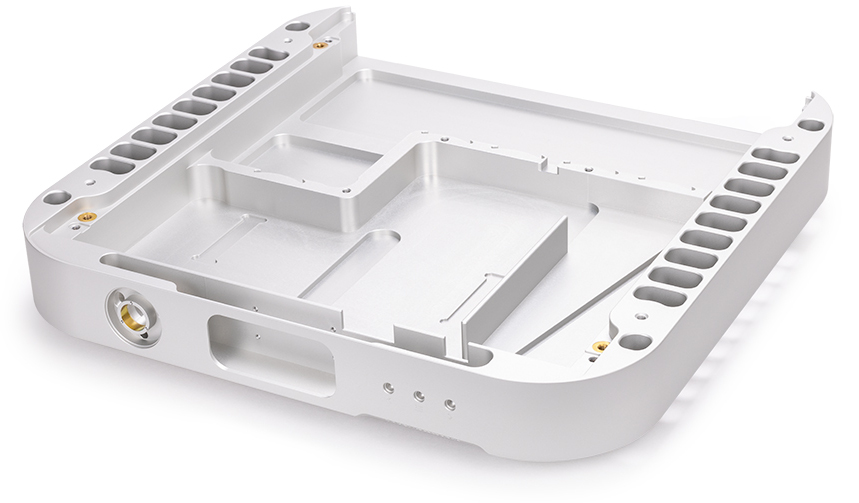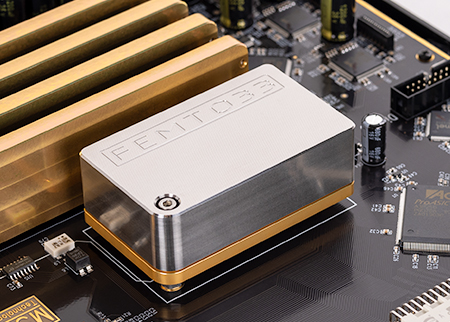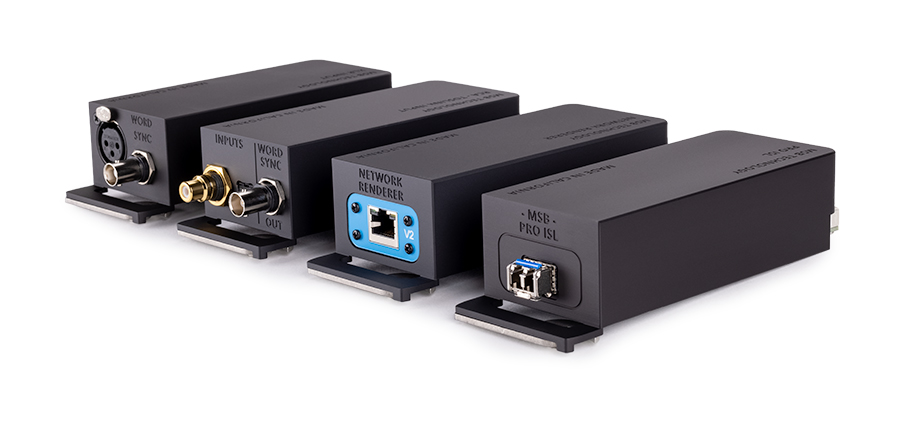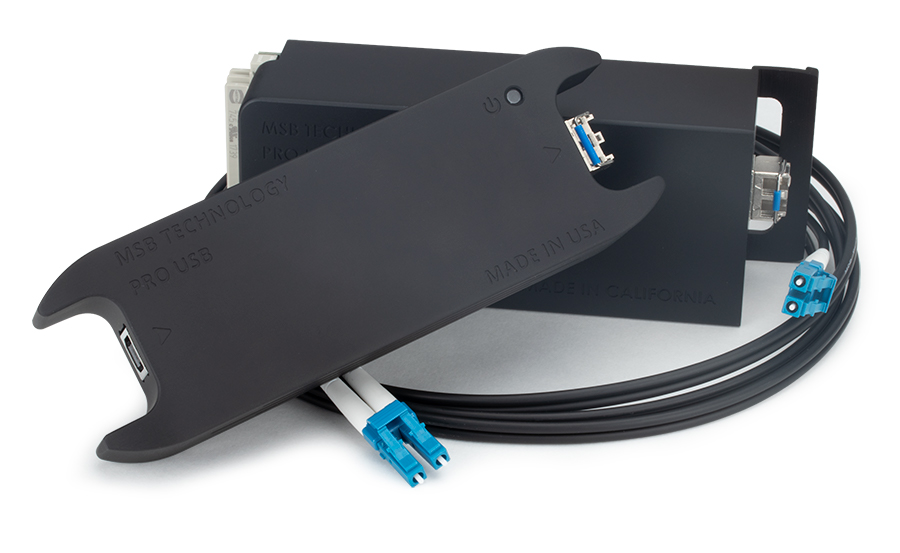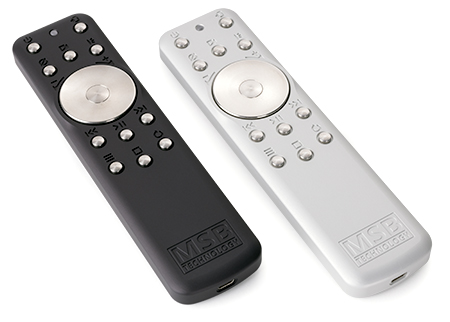MSB The Reference DAC
Digital sources
The MSB The Reference DAC coiled slowly around me (and my ears), minute by minute, not to suffocate, rather to leave me breathless. It is as if the equipment and the room became weightless and the air remained the only medium to carry the sound. The experience was truly transcendent.
Function and form
The MSB The Reference is built with a fanatic care for signal purity, from input to output. There are no buffers, current-to-voltage converters, or transistors in the signal path, and there are no active devices after conversion used at all. At the heart of it there are four Hybrid DACs, a current evolution of 20 years of MSB’s experience in building discrete DACs. The Hybrid DACs are individually shielded and fully balanced to the point of conversion that helps reject noise and maintain high resolution, and can operate up to 6Mhz for PCM, and up to 50MHz for DSD. The conversion is clocked by two
ultra-low jitter Femto 33 clocks. Before the audio playback starts, the DAC determines the base sample rate and selects the correct playback clock. MSB claims that “the vast majority of digital audio was recorded within two different frequency families: multiples of 44.1kHz and multiples of 48kHz. The 44.1kHz family includes CD, DSD and many hi-res formats such as 176.4kHz. The 48kHz family includes most sound recorded along with video and many hi-res formats, such as 96kHz and 192kHz audio. But there are differences between these two frequency families. One oscillator–such as 10Mhz or 27MHz–can be converted into the frequencies required to play back both the 44.1kHz and 48kHz families. However, the electrical circuits required are extremely lossy, leading to a large degradation of clock precision. The best solution is to have an independent clock oscillator for each frequency family chosen for each playback scenario”. At the same time, MSB argues that external clocks are sub-optimal for digital audio because “A clock signal is a fast-moving precision electrical signal and is extremely sensitive to added noise or distortion. Each time it’s buffered or transmitted, a portion of its precision is lost. Even if a small amount of noise couples into the clocks, jitter will increase dramatically. A clock sent over an ultra-high quality cable will still increase its jitter considerably. The best solution is to create the lowest jitter clock as close to the DAC as possible”.
There are two very essential boxes attached to the DAC. The first is an external power supply (The Reference Powerbase) with separate digital and analog sides. The second addition is less visible as it is a smallish interface that is to be connected between a computer and the DAC. So called The Pro USB/Pro ISL solution is asynchronous electrical isolation between the source and the DAC. MSB asserts that removing the digital playback source from the room is the best one can do to eliminate another noise-generating component. The Pro ISL facilitates running up to 1km cable lengths between the USB module and the DAC. The only disadvantage is that you won’t be able to control the DAC from the computer. This does not represent a big problem, considering that MSB included lossless volume control in The Reference DAC.
Bass management
I mentioned the MSB’s fanatical attention to detail, and if you don’t have enough, here’s another example: The MSB The Reference DAC has a large white matrix display, a one that is easy to read from the listening seat, no matter how far it is. The display is controlled by the clock and is refreshed between data processing to prevent interference. No need to add that the display is shielded too. All the small pieces of attentive engineering that MSB put into The Reference DAC summed up into an incredible whole.
I listened to an acoustic version of Srdce jako kníže Rohan, a live piece from Richard Muller´s Concert album (2018). Both the singer and his girls (read “a choir of three”) were presented with natural and detailed voices that were spitting out of the speakers similarly to how they do through a concert PA system. It was certainly different from what I usually experience – the sound always travels from the speakers, it pours into the room, it connects to my ears. With the MSB the event was instant. No travelling at the speed of sound, the sound accelerated to the speed of light. The absence of any latency removed the electronics from the listening equation, and everything was now. This sensation was supported by unconstrained dynamics, so the performance was very authentic. Not only voices were otherworldly - the bass guitar exhibited the detail of each string plucked, with an initial scratchy transient followed by the resonance. The saxophone was amazing too, as was the trombone and the trumpet. The brass instruments had remarkable bloom and hilarious instrumental colours. There was nothing ´digital´ about The Reference DAC. The sound was rich and deep, and fascinatingly detailed and liquid, as if the sampling frequency was infinite.
Clarity & delicacy
I wrote about Dee Dee Bridgewater‘s Slow Boat to China (Live at Yoshi´s) in my review of Simaudio Moon 860A V2 power amplifier, that used a very similar audio set-up. I was raving about how the transients of a tambourine hitting the stage floor were strong and dynamic, and how colourful the sound of piano was. The MSB The Reference DAC, connected to the MSB The 202 stereo power amplifier, elevated this experience by a remarkable margin. In my opinion, it was how the DAC treated the colour what made the biggest difference. It was as if you the DAC was able to analyze each colour down to its primary values, as if I used a glass prism see them. They were vivid and physical, and totally natural. Even some questionable recordings like the funny dixieland piece Jožin z bažin (Ivan Mladek) were elevated into a reference recording that could be used at any high-end show. Well, this particular song has been aspiring to become a classic since Metallica performed it live at their Prague’s concert, so download and listen for yourself.
Tonal accuracy
I mentioned the dynamics and colours. Not surprise then that the way The Reference DAC handled harmonics was another MSB’s magic. There was an equal attention given to the fundamental and all its harmonics. The sound is ultra-clean, but not ultra-clean is the usual high-end terms. Yes, there was clarity, dust-free soundstage, effortlessness, and quiet background, but none of it was really noticeable. What was noticeable though, was the absolute absence of anything electronic in the sound. The experience was like living in an enhanced reality, rather than listening to a playback system. Not unlike were my senses sharpened my some kind of a drug (they weren’t, for the record).
In Brothers In Arms (Dire Straits) I could hear the differences of how the individual instrumental tracks were processed. The album was one of the first recorded on a 24-track digital DAT. Although the result sounds like a spontaneous performance, the recording process – under supervision of Mark Knopfler and sound engineer Neil Dorsfman – was a chore, with tons of overdubs and re-recordings. At one moment it was even decided to erase all the drum tracks of Terry Williams and replace it with the drum tracks recorded by Omarem Hakim, a hired jazz drummer. Still, there is a little Williams’ intro to Money for Nothing that had survived, and the MSB will let you hear the minute differences in the drumming style. Through The Reference DAC it is clear that the flute in Ride Across The River is synthesized, as well as it is clear that the overdubbed trumpet was compressed too much to dynamic flatness.
Spatial resolution
The MSB The Reference DAC isn’t an affordable piece of equipment – its price tag equals a new Mercedes-Benz E 400d 4Matic. Plus, one needs to consider that the MSB devices are built for a brand ecosystem, so it is wise to think about acquiring an MSB power amplifier too. The company does not currently produce any preamps for they see no point in adding another source of noise, and the volume can be comfortable controlled through the DAC, so you may be wanting to buy some MSB extension modules too. That way the total amount of money gets truly stratospheric. For many, there will be an escape route: MSB The Discrete DAC, a device that costs 25% of The Reference, and – supposedly – should deliver the most of its sonic wonder. This logic is obvious but I have to disappoint: The Discrete DAC was available too, and I could compare both devices under completely identical conditions. The Discrete DAC is a stunning DAC, but The Reference leaves it behind. It is not a close shave, the gap between the two is wide. The main difference is the difference of watching a live performance on TV and be at the performance. Maybe it is better not to audition the MSB The Reference DAC, for your audio world will never be the same afterwards. It is a phenomenal DAC.
P.S. MSB has a unique trade-in program policy. Through their distributors, they offer up to 100% for your existing MSB product when you decide to step up and acquire a new one. I wish every audio brand has something like this.
Recommended resellers
CZ/SK: Platan Audio, Hlohovec, tel. +421 905 409 802
Manufacturer's website: http://www.msbtechnology.com
Associated components
- Sources: Antipodes K50 Music Server, JRiver Media Center 22/Acer Inspire V Nitro, Simaudio Moon 750D D/A converter a CD transport, MSB The Discrete DAC
- Amplifiers: MSB The S202 Stereo power amplifier
- Interconnects and speaker cables: Stealth Audio Sakra V17, Synergistic Research Galileo SX USB, MSB The Pro ISL/Pro USB Block
- Loudspeakers: Legacy Audio Whisper XDS
- Power conditioning: Stealth Audio Dream V18, Synergistic Research PowerCell 12 UEF SE, Synergistic Research Euphoria Level 3 HC, Galileo SX and SRX, MSB Hybrid Pro
ACCUPHASE DG-58
The Accuphase DG-58 is a 4th generation 'voicing equalizer' of Japanese manufacturer. The device won me over with its impeccable finish, top notch operation and a friendly user interface. It comes in traditional satin gold with high ...
Recommended resellers
Nisel SK, Bratislava, tel. +421 905 203 078
ACCUPHASE DP-720 SACD
Accuphase engineers further expanded on the features that had made their DP-900/DC-900 transport/DAC combo so phenomenal - the result is the one-box DP-720. This player is built with almost fanatical attention to detail. The ...
Recommended resellers
Nisel SK, Bratislava, tel. +421 905 203 078
ACCUPHASE DP-770 SACD
Every new product from this Japanese manufacturer is a small feast, especially if it is a device positioned at the top of the product line. Also, although affordability may be a relative term, spending under 20,000 euro for a digital ...
Recommended resellers
Perfect Sound Group, Praha, tel. +420 722 960 690
Nisel SK, Bratislava, tel. +421 905 203 078
ARIES CERAT Kassandra II Reference DAC
After spending time with the Aries Cerat device I believe I better understand why there is so much enthusiasm about the brand in hifi circles. The Kassandra DAC, if set up properly, provides pure and strong sound that combines ...
Recommended resellers
Mecca Highend s.r.o., Vraclav, +420 732 576 216
AUDIOLAB 8300CD
The 8300CD is a preamplifier, a CD player and a DAC (ESS Sabre), all in one neat package. Audiolab offers 8300MB monoblocks that are half-width of the 8300CD so the two monos and one source component create a compact high end system. ...
Recommended resellers
Horn Distribution, Praha, +420 272 656 485
AUDIOQUEST Dragonfly Red
The original USB DAC of Audioquest happened to be a small revolution back in 2012. Four years later there are already more newborn dragonflies – v1.2, Black and Red. This review is focusing on the latest Red version that has ...
Recommended resellers
AQ s.r.o., Červenka, tel. +420 585 342 232
AYON CD-07s
Smooth liquidity is another typical element of the Ayon sound. The sound is analog-like, viscose, fluid, flowing, smooth. You may as well discard all these adjectives and replace them with the single formulation: the Ayon is a ...
Recommended resellers
Nisel SK, Bratislava, tel. +421 905 203 078
